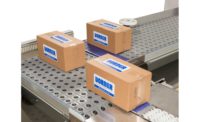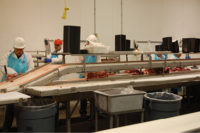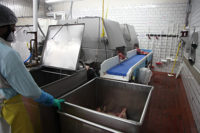On a conveyor surface, potential harborage points are numerous, including links, bends, etc. While smooth conveyor belts tend to be easier to clean, they also are easier to damage, i.e. fraying edges, gouges, etc. That damage becomes impossible to clean and sanitize, says Andrew Lorenz, founder and president of We R Food Safety, Menomonie, Wis.
“The primary issue the industry faces with conveyors is the time it takes to properly remove debris and then sanitize,” he says.
Depending on application, conveyors face specific challenges as well, says Jeff Sindelar, associate professor and extension meat specialist at the University of Wisconsin-Madison. For example, processors who use conveyors for raw products are concerned with film buildup of fats and proteins.
The cost of maintenance is another challenge.
“When making the initial purchase you have to compare the added cleaning and sanitizing cost of link types against replacement cost of belt types,” Lorenz says.
Some of the questions Lorenz suggests that processors making the initial purchase need to ask themselves include:
- Can I easily resurface the conveyor?
- Can my cleanup crew remove all debris and get sanitizer into link contact points, especially in ready-to-eat environments?
- What is the expected useful life of the conveyor, and at what point do I replace it?
- Where is the conveyor going to be used or what should I expect for wear and tear?
Running Smoothly
Conveyors are like any other piece of equipment for processors, and do require preventative maintenance. Issues need to be addressed as they arise, Sindelar says, and not prolonged for another day, which could jeopardize food safety.
For example, for link-type conveyors worn link contact points can become impossible to sanitize, and if used in a ready-to-eat environment, may not be the right choice, Lorenz says.
“Belt conveyors that are prone to fraying should be inspected daily, and for those that can be resurfaced, a scheduled resurfacing of them based on volume or conditions,” he adds.
New materials are making maintenance easier on belt types as well as better designs of the contact points on linked belts.
“One of the most exciting improvements recently has been the use of cleaning and sanitizing bars during processing,” Lorenz says.
For example, he recently saw a new spray system that sprays a non-flammable alcohol sanitizer in ready-to-eat environments. He also has seen dramatic improvements in ozone sprays during production.
“In the facilities that have implemented these types of spray systems, we have seen zero pathogen findings as well as greatly reduced spoilage bacteria contamination,” Lorenz says.
Moving forward, several companies that produce different conveyor systems have mentioned they are working on ways to make disassembly easier and faster, Lorenz says.
“This will go a long way to improving the sanitation vulnerability that is presented by linked conveyor systems,” he explains.
For conveyor belting, Lorenz hopes to see better materials for the belts themselves as well as equipment that is designed to protect the edges from fraying.
“There is nothing worse than finding out that your belt has been fraying and now you have contaminated product,” he says. IP








